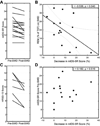Antidepressant effects of selective slow wave sleep deprivation in major depression: a high-density EEG investigation
- PMID: 21397252
- PMCID: PMC3119746
- DOI: 10.1016/j.jpsychires.2011.02.003
Antidepressant effects of selective slow wave sleep deprivation in major depression: a high-density EEG investigation
Abstract
Sleep deprivation can acutely reverse depressive symptoms in some patients with major depression. Because abnormalities in slow wave sleep are one of the most consistent biological markers of depression, it is plausible that the antidepressant effects of sleep deprivation are due to the effects on slow wave homeostasis. This study tested the prediction that selectively reducing slow waves during sleep (slow wave deprivation; SWD), without disrupting total sleep time, will lead to an acute reduction in depressive symptomatology. As part of a multi-night, cross-over design study, participants with major depression (non-medicated; n = 17) underwent baseline, SWD, and recovery sleep sessions, and were recorded with high-density EEG (hdEEG). During SWD, acoustic stimuli were played to suppress subsequent slow waves, without waking up the participant. The effects of SWD on depressive symptoms were assessed with both self-rated and researcher-administered scales. Participants experienced a significant decrease in depressive symptoms according to both self-rated (p = .007) and researcher-administered (p = .010) scales, while vigilance was unaffected. The reduction in depressive symptoms correlated with the overnight dissipation of fronto-central slow wave activity (SWA) on baseline sleep, the rebound in right frontal all-night SWA on recovery sleep, and the amount of REM sleep on the SWD night. In addition to highlighting the benefits of hdEEG in detecting regional changes in brain activity, these findings suggest that SWD may help to better understand the pathophysiology of depression and may be a useful tool for the neuromodulatory reversal of depressive symptomatology.
Copyright © 2011 Elsevier Ltd. All rights reserved.
Conflict of interest statement
Conflict of interest statement
Dr. Peterson has received unrelated research support from Sanofi-Aventis. Dr. Tononi has consulted for Sanofi-Aventis and Takeda, and he is currently the David P. White Chair in Sleep Medicine at the University of Wisconsin – Madison, endowed by Phillips Respironics. Dr. Tononi has also received unrelated research support from Phillips Respironics. Dr. Benca has consulted for Merck and Sanofi-Aventis. The other authors have indicated no financial conflicts of interest.
Figures



Similar articles
-
Concomitant BDNF and sleep slow wave changes indicate ketamine-induced plasticity in major depressive disorder.Int J Neuropsychopharmacol. 2013 Mar;16(2):301-11. doi: 10.1017/S1461145712000545. Epub 2012 Jun 7. Int J Neuropsychopharmacol. 2013. PMID: 22676966 Free PMC article. Clinical Trial.
-
Sleep-dependent improvement in visuomotor learning: a causal role for slow waves.Sleep. 2009 Oct;32(10):1273-84. doi: 10.1093/sleep/32.10.1273. Sleep. 2009. PMID: 19848357 Free PMC article.
-
The selective orexin-2 antagonist seltorexant (JNJ-42847922/MIN-202) shows antidepressant and sleep-promoting effects in patients with major depressive disorder.Transl Psychiatry. 2019 Sep 3;9(1):216. doi: 10.1038/s41398-019-0553-z. Transl Psychiatry. 2019. PMID: 31481683 Free PMC article. Clinical Trial.
-
[Biological models of depression: effect of antidepressants on sleep].Encephale. 1995 Dec;21 Spec No 7:35-40. Encephale. 1995. PMID: 8929677 Review. French.
-
Novel Augmentation Strategies in Major Depression.Dan Med J. 2017 Apr;64(4):B5338. Dan Med J. 2017. PMID: 28385173 Review.
Cited by
-
The dynamic responses of mood and sleep physiology to chronic sleep restriction and subsequent recovery sleep.Sleep. 2024 Sep 9;47(9):zsae091. doi: 10.1093/sleep/zsae091. Sleep. 2024. PMID: 38602131 Clinical Trial.
-
Daytime dexmedetomidine sedation with closed-loop acoustic stimulation alters slow wave sleep homeostasis in healthy adults.BJA Open. 2024 Mar 28;10:100276. doi: 10.1016/j.bjao.2024.100276. eCollection 2024 Jun. BJA Open. 2024. PMID: 38571816 Free PMC article.
-
Inflammatory hypotheses of sleep disturbance - depression link: Update and research agenda.Brain Behav Immun Health. 2023 Jun 22;31:100647. doi: 10.1016/j.bbih.2023.100647. eCollection 2023 Aug. Brain Behav Immun Health. 2023. PMID: 37408788 Free PMC article.
-
Profile of sleep disturbances in patients with recurrent depressive disorder or bipolar affective disorder in a tertiary sleep disorders service.Sci Rep. 2023 May 31;13(1):8785. doi: 10.1038/s41598-023-36083-7. Sci Rep. 2023. PMID: 37258713 Free PMC article.
-
Sex differences in amygdalohippocampal oscillations and neuronal activation in a rodent anxiety model and in response to infralimbic deep brain stimulation.Front Behav Neurosci. 2023 Feb 23;17:1122163. doi: 10.3389/fnbeh.2023.1122163. eCollection 2023. Front Behav Neurosci. 2023. PMID: 36910127 Free PMC article.
References
-
- American Psychiatric Association., & American Psychiatric Association. Task Force on DSM-IV. Diagnostic and statistical manual of mental disorders : DSM-IV-TR. 4th ed. Washington, DC: American Psychiatric Association; 2000.
-
- Benca R, Obermeyer W, Thisted R, Gillin J. Sleep and psychiatric disorders. A meta-analysis. Arch Gen Psychiatry. 1992;49:651–668. discussion 669-70. - PubMed
-
- Benedetti F, Smeraldi E. Neuroimaging and genetics of antidepressant response to sleep deprivation: implications for drug development. Curr Pharm Des. 2009;15:2637–2649. - PubMed
-
- Borbély A. The S-deficiency hypothesis of depression and the two-process model of sleep regulation. Pharmacopsychiatry. 1987;20:23–29. - PubMed
Publication types
MeSH terms
Substances
Grants and funding
LinkOut - more resources
Full Text Sources
Other Literature Sources
Medical
Research Materials


